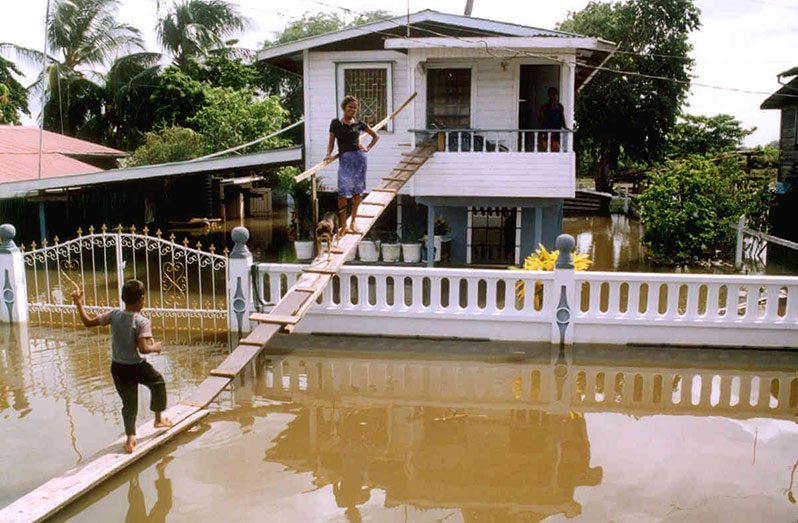AS part of its Flood Risk Management Project, the Guyana Government is moving to develop an Emergency Preparedness and Response Plan (EPRP) for Region Four (Demerara Mahaica). Only recently, the Ministry of Agriculture released an advertisement inviting consultants to undertake the project to prepare the plan, based on the findings of the Common Alerting Protocol (CAP) studies, which is an international, non-proprietary digital message format for exchanging all-hazard emergency alerts.
The ministry indicated that once crafted, the plan will lend critical support to the work of Guyana’s Civil Defence Commission (CDC), especially with regard to managing the public response to potential flood emergency; this is particularly in relation to preparedness, education, as well as planning and implementation in the event of hazardous conditions.
“This is required to improve the preparedness and resilience of communities and assets in the flood hazard zones, and reduce the related damages and losses in the cases of extraordinary floods,” the advertisement noted.
It specified, too, that the eventual implementation of the plan would be critical in the context of the East Demerara Water Conservancy (EDWC), and, more importantly, in the event of potential dam failure and overtopping.
The public notice outlined the deadline for the submission of Expressions of Interest (EoI) as being March 31, 2021. Once a consultant is selected, he/she/them will have a timeline of three months, by which they would need to submit the detailed plan.
Being a country situated below sea level, Guyana remains susceptible to constant flooding, especially during the rainy seasons. It was this that led to the aggressive rolling out of the Guyana Flood Risk Management Project, which seeks to ensure that Guyana has all policy mechanisms in place to prevent floods and respond effectively to instances of flooding.
It was only in November 2020 that the Board of Executive Directors of the World Bank approved US$26 million in additional financing for Guyana to support the ongoing Guyana Flood Risk Management Project. These monies are intended to help to improve Guyana’s climate resilience, protect economic activity, and reduce the impact of natural disasters.
BELOW SEA LEVEL
In providing the support, World Bank Resident Representative for Jamaica and Guyana, Ozan Sevimli reminded that 90 per cent of Guyana’s inhabitants live on the narrow coastal plain, much of which lies below sea level. As a result, it was recognised that flooding poses a serious and recurrent risk to both the lives of people and to livelihoods in the agricultural sector.
“These additional resources will help protect some of the country’s most populous areas and build greater resilience,” Sevimli said.
The Guyana Flood Risk Management Project aims to significantly increase flood resilience in the low-lying coastal lands of the East Demerara area, which includes Georgetown, where much of the population as well as administrative and commercial activities are concentrated.
A statement issued by the World Bank late last year said that the additional financing will include extensive work to improve the East Demerara Water Conservancy (EDWC), which is one of Guyana’s major water storage and flood control facilities.
“The project will improve the drainage systems that ensure the integrity of the EDWC dams. Water stored in the EDWC dam is used to irrigate agricultural lands, provide water for use in homes, and reduce the risk of flooding,” the statement explained.
The project also features the rehabilitation of small existing irrigation structures, capacity building, communication, and outreach activities to better inform the public about the threats and response mechanisms that are in place to address flooding, especially along the coastland.
“These activities are expected to contribute to reducing the outbreaks of infectious illnesses due to flooding, alleviating the burden on the healthcare system that is currently managing the COVID-19 pandemic,” the statement noted.
Additionally, the press release highlighted the fact that Guyana receives interest-free financing from the International Development Association (IDA) “with a maturity of 40 years, including a grace period of 10 years”.
In 2005, the majority of Guyana’s coastland was devastated by massive floods that displaced hundreds of families and resulted in millions of dollars in losses, including livestock. The floods also resulted in a notable outbreak of a number of water-borne diseases, including Leptospirosis, which led to the loss of lives.
Since then, successive administrations have committed to instituting systems that could effectively minimise any possibility of flooding. As of recent, the country’s national 2021 budget saw the allocation of some $5.1 billion to further strengthen the country’s sea and river defence infrastructure.




.png)









